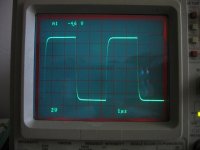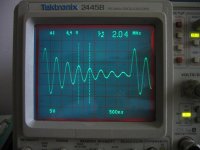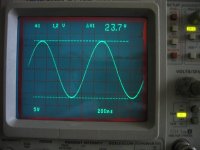Hi Vladimir,
yes I understand what you mean. It would be the real issue if we found low level signal like -60dB in the audio band (say 10Hz - 40kHz) that has been suppressed by the amplifier in the presence of high level say -3dB signal. Till now I have never measured such thing, if anyone has had such measurement, it would be highly appreciated to post it here. Not to open uA741 TIM issue, please
yes I understand what you mean. It would be the real issue if we found low level signal like -60dB in the audio band (say 10Hz - 40kHz) that has been suppressed by the amplifier in the presence of high level say -3dB signal. Till now I have never measured such thing, if anyone has had such measurement, it would be highly appreciated to post it here. Not to open uA741 TIM issue, please
Last edited:
Hi Vladimir,
yes I understand what you mean. It would be the real issue if we found low level signal like -60dB in the audio band (say 10Hz - 40kHz) that has been suppressed by the amplifier in the presence of high level say -3dB signal. Till now I have never measured such thing, if anyone has had such measurement, it would be highly appreciated to post it here. Not to open uA741 TIM issue, please
And I would add, " in the presence of high level sharp transient -3db signal relevant to audio band". Maybe definite snapshort of symphonic orchestra recorded signal shoud be digitally memorized, and then be used as a complex "single-pulse" test signal.
I am shure, in case of multistage power amp schematics, deep GNFB does play with this question.
Last edited:
And I would add, " in the presence of high level sharp transient -3db signal relevant to audio band".
This WAS definitely the issue of slow opamps like uA741, OP07 and many other. The reason was not the feedback, but low resulting slew rate (low slew rate because of feedback closed round low di/dt cap charging circuit part). This old issue is often digged out in many reincarnations
Pavel,
As a hint, all DS based AD's [and DA's] I tried have shown themselves essentially useless in noise-load testing, you never get decent notch depth with a loopback setup!
On the other hand pure analog systems seem to manage okay.
Ciao T
Not true an all analog notched noise test on a $100,000 Aglient spectrum analyser is not capable of meeting the static single tone distortion performance of the instrument (sometimes 25dB worse). Worse yet it is an instrument dependent crest factor handling issue.
Hi,
I would not presume to tell Agilent how to design their gear, but I can see only two reasons:
1) the design is bad
2) the design incorporates features that create a form of distortion that is not captured by single tone analysis, in essence the kind of distortion that some routinely deny to have even the possibility to exist, e.g. fuzzy distortion.
FWIW, the AP2 also looks much worse running something akin to a noise-load test than when running single tones. Now I do not loose sleep about this, as the AP2 is not designed to operate in this test.
When I did those we used fixed frequency LC filters with very classical analogue AC microvolt meters...
This system had around 80dB loop-back noisefloor (old, analogue, single-needle readings converted back. It is more than enough...
Ciao T
Not true an all analog notched noise test on a $100,000 Aglient spectrum analyser is not capable of meeting the static single tone distortion performance of the instrument (sometimes 25dB worse). Worse yet it is an instrument dependent crest factor handling issue.
I would not presume to tell Agilent how to design their gear, but I can see only two reasons:
1) the design is bad
2) the design incorporates features that create a form of distortion that is not captured by single tone analysis, in essence the kind of distortion that some routinely deny to have even the possibility to exist, e.g. fuzzy distortion.
FWIW, the AP2 also looks much worse running something akin to a noise-load test than when running single tones. Now I do not loose sleep about this, as the AP2 is not designed to operate in this test.
When I did those we used fixed frequency LC filters with very classical analogue AC microvolt meters...
This system had around 80dB loop-back noisefloor (old, analogue, single-needle readings converted back. It is more than enough...
Ciao T
Vladimir,
This type of behaviour has been called "Fuzzy Distortion" by some in the circle around Malcolm Hawkesford (the term has a derivation from "fuzzy logic" I believe and not the furry/fuzzy 'scope traces BTW).
It is present in many types of looped feedback systems that measure quite well normally. They may include anything, I have experienced this phenomena with control loops in both industrial and military applications. It presented itself as a hysteresis that dependent on the signal history and could result in rather drastic failures of such systems.
In audio we encounter them routinely in looped feedback amplifiers and other looped feedback systems such as Delta Sigma noise-shaping and the related processes in Class D Amplifiers.
Plus, the issue is additionally that the "wrong" reaction to the small signal is not reliably predicted by traditional non-linearity measurements (HD and IMD) and so such measurements are often exemplary.
I found that classic noise loading testing can reveal what I believe to be the results of this behaviour where the distortion results of noise load testing are dramatically higher than what is revealed by classic HD testing.
Ciao T
Fuzzy logic as I recall was something promoted by some Japanese companies in the early eighties, and it was mainly applied to control systems with inputs such as thermostats or other sensors. In conventional control loops, the sensor could adopt only two positions, on or off, and would feed back into a system that would subsequently only have two positions, on or off.
In fuzzy logic, the sensor can take intermediate positions, and so can the system that is being controlled. This can reduce over- and undershoot. Think mainly air conditioners and under the table heaters here.
Fuzzy logic, in other words, is a logic that is not just based on 'false' or 'true', but which knows intermediary steps, which you could call 'half-truths'. I have been using the term in situations where (in my opinion) people sincerely believe in those.
What baffles me, is that you have been posting on 'fuzzy distortion' in Class D and some DA converters, but you appear to have no clear definition of what it means.
The sort of fuziness you see on a scope at the output of a class D amplifier, or as Scott showed many pages ago at the output of a DA converter, apperently is not what you mean. I am happy with that, because the sort of fuz you see on a scope as a remainder of the switching frequency of a class D amplifier, has no bearing on sound quality. Actually, it is a pet hypothesis of mine that the high frequency fuz a class D amplifier generates may even be beneficial to sound quality, but that is a different story altogether
vac
Probably -60dBVU
Nothing, it was already explained.
What I am missing?
Nothing, it was already explained.
Fuzzy logic as I recall was ...
vac
I would not pay much attention who was saying what, when and why, just I try to attract attention to the fact, that any fast and high amplitude signal puts an amp in some "problems", any amp needs some time period to "get normal" after sharp disturbance, includind that it must get in equilibrium with GNFB signal, and while it is during settling period, it can pay no attention to low-level signals, comparable in amplitude with FB error signal (this is only one possible mechanism), and some tiny information can be simply lost. Even if the remaining higher-level periodic-like signal components will be perfectly delivered to the speakers, the sound can not be live-like without even part of low-level components.
They are just TONES, PMA, not transients. Tones are easy, and predictable.
How does a piece of audio equipment predict anything?
se
Again, the test is not very difficult. We can take music signal recorded at -60dB from vinyl, tape, CD, 24/96 and SACD, amplify it to 0dB level and compare the results. Many have probably done that, and me as well. 24/96 and SACD are the winners, as expected. From vinyl, we get groove hum, from tape we get hiss.
IMO it is the LIMITED resolution of details that might be the main the reason why vinyl and tape are preferred. These signal sources require LESS quality of amplifiers and speakers.
It may be so, however my experience, so far, indicates that it may be not so. The better my stereo set gets, the more vinyl records sound better to me. Possibly vinyl records sound better to me because of reasons other than very low levels details, details which aren't there on those records. So, maybe very low levels details aren't the whole story, concerning sound quality.
I found that classic noise loading testing can reveal what I believe to be the results of this behaviour where the distortion results of noise load testing are dramatically higher than what is revealed by classic HD testing.
Hi Thorsten,
What is that "noise loading testing"?
Would you care to elaborate?
They are just TONES, PMA, not transients. Tones are easy, and predictable.
Makes no difference. The record is real - time, non-averaged.
It was just a hypothetical example. Actually 10uS would be a better choice.
What lasts only 10uS in any musical performance?
se
Anyway Vladimir, the thoughts without quantification may be empty. Will this audio preamp have troubles you are describing?
PMA, I think that amp's speed tell only part (maybe important) of the story.
With this No GNFB headphone amp I have got not worse or even better speed, but I can say nothing how it handles low-level signals.
http://www.diyaudio.com/forums/solid-state/185386-no-nfb-headphone-pre-amp.html#post2509272
I would repeat again, we should design special single pulse signal, including big and small components, and observe an output in a way resembling by sensitivity what was done by Ed Simon.
- Status
- Not open for further replies.
- Home
- Member Areas
- The Lounge
- John Curl's Blowtorch preamplifier part II



